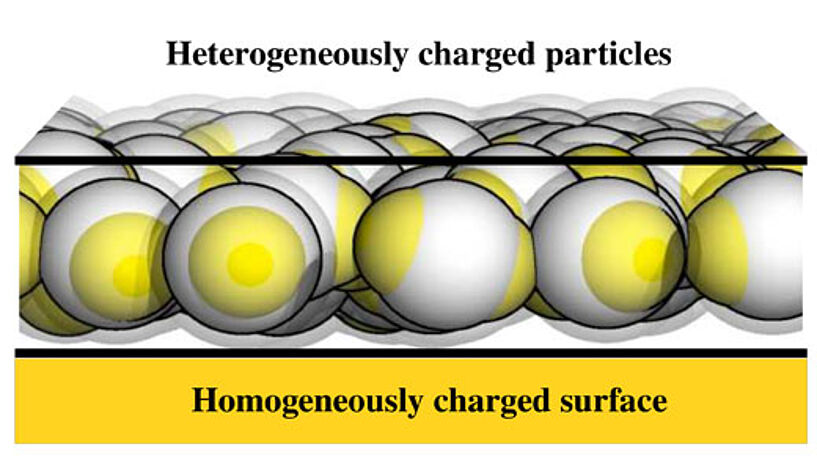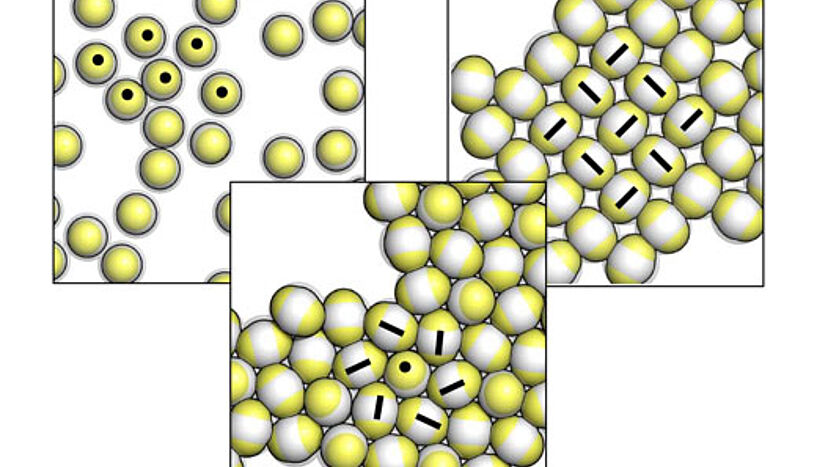Nano World: Where towers construct themselves
02. Juni 2014How Physicists get control on the self-assembly process
Imagine a tower builds itself into the desired structure only by choosing the appropriate bricks. Absurd – and however, in the nano world this is reality: There an unordered crowd of components can initiate the formation of an ordered structure – a process known as self-assembly. The physicists Christos Likos (University of Vienna), Emanuela Bianchi and Gerhard Kahl (both Vienna University of Technology) investigate how they can control the ordering of such self-assembling structures and found out how to switch the assembly process on and off. The results are now published in the high-impact journal "Nano Letters".
Materials with specific properties at the nano- and micro-scale level are heavily sought after due to the broad spectrum of applications in electronics, photovoltaics and biomimetic material synthesis. For many of these applications, mesoscopic crystalline structures are often needed and hence scientists have to deal with the challenge of developing reliable, efficient and cheap methods to produce target structures with specific symmetries and physical properties. Nowadays, rather than relying on externally-controlled tools, most of the fabrication methods are based on the self-assembly of carefully chosen/synthesized base units. The macroscopic counterpart would correspond to building a tower or a bridge just by choosing the appropriate bricks and letting them self-organize into the desired structure.
In the vast realm of functional nano- and micro-scale materials, the realization of mono- and bi-layer assemblies on surfaces is of paramount relevance. Low-dimensional systems with well-defined features have indeed applications as e.g. antireflection coatings, biosensors, data-storage, optical and photovoltaic devices, or catalysts. The properties of these materials strongly depend on a delicate balance between the properties of the assembling units and those of the underlying surface.
In our contribution we focused on nano-units with a complicated surface pattern, consisting of regions with different surface charge. The investigated units are mostly negatively charged with the exception of the positively charged polar regions on the top and at the bottom of the particles. Similar non-homogeneously charged units appear either in biosystems, e.g. viral capsids and proteins, or in experimentally synthesized systems, e.g. virus-like nano-particles, spotted vesicles and nano-cubes covered with specific metals.
In the up-coming paper we focused on the self-assembly of the described heterogeneously charged particles in the vicinity of a homogeneously charged substrate. Our computer simulations showed how complex structures at the nano-scale level can spontaneously emerge and how it is possible to reliably control the ordering of the particles into specific, quasi two-dimensional aggregates. Depending on different parameters, such as the particle/wall charge and the extension of the charged regions on the particle surface, our units can form surface layers with different densities (and possibly different responses to external stimuli): sometimes particles assemble into close-packed, hexagonally ordered crystalline aggregates, sometimes they form open, square-like layers, sometimes they do not assemble at all. Our work was able to investigate the variety of the self-assembled structures offered by the chosen bricks and to characterise the specific collective behaviors occurring on tuning the relevant parameters of these systems. Moreover and most importantly, we showed that upon subtle changes of either the pH of the solution or of the electrical charge of the substrate, it is possible to reversibly switch the assembly process on and off as well as to induce a transformation from a one specific spatial/orientational arrangement to another.
Publication in "Nano Letters":
Emanuela Bianchi, Christos N. Likos und Gerhard Kahl: Tunable Assembly of Heterogeneously Charged Colloids. In: Nano Letters (2014).
http://pubs.acs.org/doi/abs/10.1021/nl500934v
Scientific Contacts
Univ.-Prof. Dipl.-Ing. Dr. Christos N. Likos
Computational Physics
University of Vienna
1090 Vienna, Sensengasse 8
T +43-1-4277-732 30
christos.likos(at)univie.ac.at
Emanuela Bianchi, Ph.D.
Soft Matter Theory
Vienna University of Technology
+43-1-58801-13631
emanuela.bianchi(at)tuwien.ac.at
Press Contact
Mag. Veronika Schallhart
Press Office
University of Vienna
1010 Vienna, Universitätsring 1
T +43-1-4277-175 30
M +43-664-602 77-175 30
veronika.schallhart(at)univie.ac.at
Wissenschaftlicher Kontakt
Univ.-Prof. Dipl.-Ing. Dr. Christos N. Likos
Fakultät für PhysikUniversität Wien
1090 - Wien, Sensengasse 8/15
+43-1-4277-732 30
christos.likos@univie.ac.at
Rückfragehinweis
Mag. Veronika Schallhart
DLE ÖffentlichkeitsarbeitUniversität Wien
1010 - Wien, Universitätsring 1
+43-1-4277-17530
+43-664-8176793
veronika.schallhart@univie.ac.at


